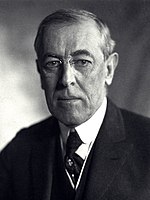1916_United_States_presidential_election_in_Michigan
1916 United States presidential election in Michigan
Election in Michigan
The 1916 United States presidential election in Michigan took place on November 7, 1916, as part of the 1916 United States presidential election. Voters chose 15[1] representatives, or electors, to the Electoral College, who voted for president and vice president.
Following the Panic of 1893 and the Populist movement, Michigan would turn from a competitive Republican-leaning state into a rigidly one-party polity dominated by the Republican Party.[2] The dominance of the culture of the Lower Peninsula by anti-slavery Yankees[3] would be augmented by the turn of formerly Democratic-leaning German Catholics away from that party as a result of the remodelled party’s agrarian and free silver sympathies, which became rigidly opposed by both the upper class and workers who followed them.[4] The state Democratic Party was further crippled via the Populist movement severing its critical financial ties with business and commerce in Michigan as in other Northern states.[5] A brief turn of the strongly evangelical Cabinet Counties toward the Populist movement in the 1896 presidential election would reverse itself following the return to prosperity under President William McKinley, so that these joined in Republican hegemony until the Great Depression.
In the 1894 elections, the Democratic Party lost all but one seat in the Michigan legislature,[6] and over the four ensuing decades the party would never make major gains there.[2] Unlike the other states of the Upper Midwest, the Yankee influence on the culture of the Lower Peninsula was so strong that left-wing third parties did not provide significant opposition to the Republicans, nor was there more than a moderate degree of coordinated factionalism within the hegemonic Michigan Republican Party.[7]
Aided by the support of incumbent Governor Chase Osborn[8] and state party leader Frank Knox,[9] “Bull Moose” nominee Theodore Roosevelt would carry Michigan by a double-digit margin over conservative incumbent Taft in 1912. However, Roosevelt’s personal interests took over from developing his party after the election,[10] and after voting on the first ballot for favorite son Henry Ford due to his strong desire to keep America out of World War I,[11] Michigan’s Republicans would soon shift their support in the national convention to eventual nominee Charles Evans Hughes.[12]
At the beginning of the campaign, Michigan, where Republicans had regained their customary near-monopoly of House and state legislative seats in 1914, was seen by the Hughes campaign as a safe state.[13] However, early polls, taken only from rural areas of Central Michigan, indicated Wilson was receiving a substantial proportion of the 1912 “Bull Moose” vote.[14] No further polls would be taken in the state, and in the end Hughes won slightly more than 52 percent of the popular vote.[15]


